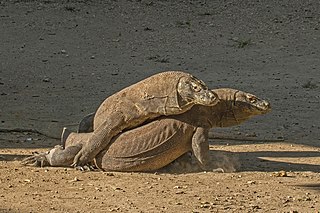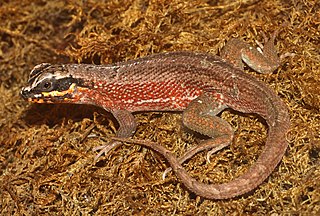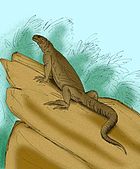
The Iguanidae is a family of lizards composed of the iguanas, chuckwallas, and their prehistoric relatives, including the widespread green iguana.

The Varanidae are a family of lizards in the superfamily Varanoidea and order Anguimorpha. The family, a group of carnivorous and frugivorous lizards, includes the living genus Varanus and a number of extinct genera more closely related to Varanus than to the earless monitor lizard (Lanthanotus). Varanus includes the Komodo dragon, crocodile monitor, savannah monitor, the goannas of Australia and Southeast Asia, and various other species with a similarly distinctive appearance. Their closest living relatives are the earless monitor lizard and chinese crocodile lizard. The oldest members of the family are known from the Late Cretaceous of Mongolia.

Iguania is an infraorder of squamate reptiles that includes iguanas, chameleons, agamids, and New World lizards like anoles and phrynosomatids. Using morphological features as a guide to evolutionary relationships, the Iguania are believed to form the sister group to the remainder of the Squamata, which comprise nearly 11,000 named species, roughly 2000 of which are iguanians. However, molecular information has placed Iguania well within the Squamata as sister taxa to the Anguimorpha and closely related to snakes. The order has been under debate and revisions after being classified by Charles Lewis Camp in 1923 due to difficulties finding adequate synapomorphic morphological characteristics. Most Iguanias are arboreal but there are several terrestrial groups. They usually have primitive fleshy, non-prehensile tongues, although the tongue is highly modified in chameleons. The group has a fossil record that extends back to the Early Jurassic. Today they are scattered occurring in Madagascar, the Fiji and Friendly Islands and Western Hemisphere.

Huehuecuetzpalli mixtecus is an extinct lizard from the Early Cretaceous Tlayúa Formation in Tepexi de Rodríguez, Central Mexico. Although it is not the oldest known lizard, Huehuecuetzpalli may be amongst the most basal members of Squamata, making it an important taxon in understanding the origins of squamates.

Gobiguania is an extinct clade of iguanian lizards from the Late Cretaceous. All known gobiguanians are endemic to the Gobi Desert of Mongolia. Gobiguania was given a phylogenetic definition by Jack Conrad and Mark Norell in 2007 as all taxa more closely related to Anchaurosaurus gilmorei than to Iguana iguana, Crotaphytus collaris, or Agama agama. According to Conrad and Norell's phylogenetic analysis, Gobiguania includes Anchaurosaurus as well as several other Late Cretaceous lizards such as Ctenomastax, Temujinia, Saichangurvel, and Zapsosaurus. A phylogenetic analysis published in 2012 indicated that three other lizard genera — Igua, Isodontosaurus, and Polrussia, all from Mongolia and all from the Late Cretaceous — are also gobiguanians. Below is a cladogram from the analysis:

Scincogekkonomorpha is a clade of lizards that includes scleroglossans and all lizards more closely related to scleroglossans than to iguanians. These "stem" scleroglossans include extinct lizards from the Late Jurassic and Early Cretaceous such as Bavarisaurus, Eichstaettisaurus, Liushusaurus, and Scandensia. Scincogekkonomorpha was named in 1961 and is now occasionally used as a stem-based taxon in contrast to the node-based taxon Scleroglossa. According to phylogenies based on morphological characteristics, Scincogekkonomorpha is the sister taxon of Iguania and together they make up crown group Squamata, the smallest clade including all living snakes and lizards.

Chamaeleontiformes is a hypothesized clade of iguanian lizards defined as all taxa sharing a more recent common ancestor with Chamaeleo chamaeleon than with Hoplocercus spinosus, Polychrus marmoratus, or Iguana iguana. It was named by paleontologist Jack Conrad in 2008 to describe a clade recovered in his phylogenetic analysis that included the extinct genus Isodontosaurus, the extinct family Priscagamidae, and the living clade Acrodonta, which includes agamids and chameleons. It is a stem-based taxon and one of two major clades within Iguania, the other being Pleurodonta. Below is a cladogram from Daza et al. (2012) showing this phylogeny:
Priscagamidae is an extinct family of iguanian lizards known from the Late Cretaceous of Mongolia and China and the Eocene of India, spanning a range from 83.6 to 48.6 million years ago. Probably the earliest priscagamids on indeterminate genera were found in Aptian-Albian sediments in "Hobur", Mongolia. It includes the genera Heterodontagama, Mimeosaurus, Phrynosomimus, Priscagama, and possibly Pleurodontagama. The first fossils of priscagamids were found in the Djadochta and Khermeen Tsav formations of Mongolia. More recently they have been found in the Cambay Formation in India, leading to the naming of Heterodontagama in 2013. Priscagamidae was originally described as a subfamily of Agamidae called Priscagaminae in 1984, but it was reclassified as a distinct family in 1989. Most phylogenetic analyses still find a close relationship between Priscagamidae and Agamidae, although a 2015 study found it to be basal to all other iguanian clades, warranting its removal from Iguania and placement in a larger clade called Iguanomorpha.
Heterodontagama is an extinct genus of iguanian lizard from the Early Eocene of India. It belongs to the extinct family Priscagamidae, which is otherwise only known from the Late Cretaceous of Mongolia. The type species Heterodontagama borsukae was named in 2013 from several isolated upper and lower jaws found in an exposure of the Cambay Shale in an open-pit coal mine in Gujarat.
Saichangurvel is an extinct genus of iguanian lizards from the Late Cretaceous of Mongolia. It is a member of a clade called Gobiguania, an exclusively Late Cretaceous group of iguanian lizards that was likely endemic to the Gobi Desert. The type species, Saichangurvel davidsoni, was named by paleontologists Jack Conrad and Mark Norell of the American Museum of Natural History in 2007. It is known from a single nearly complete and fully articulated skeleton called IGM 3/858, which was found eroding from a block of sandstone during a thunderstorm at a fossil locality called Ukhaa Tolgod. IGM 3/858 comes from the Djadochta Formation, which is between 75 and 71 million years in age. Just as it is today, the Gobi was a desert during the Cretaceous. IGM 3/858 may have died in a collapsing sand dune, the rapid burial preserving its skeleton in pristine condition.
Pleurodontagama is an extinct genus of iguanian lizard from the Late Cretaceous of Mongolia. The type species, Pleurodontagama aenigmatodes, was named in 1984 on the basis of a mostly complete skull and isolated lower jaw from a fossil locality called Khermeen Tsav. It has a wide skull with a flat snout, large eye sockets, and small bumps on the surfaces of the bones. Pleurodontagama was initially classified in the family Priscagamidae, which is usually grouped in a large clade of iguanians called Acrodonta, members of which are characterized by an "acrodont" dentition in which the teeth grow from the margins of the jaws. However, Pleurodontagama is unusual in that it has a sub-pleurodont dentition, meaning that some of its teeth grow from the inner surfaces of the jaw. There is also evidence to suggest that its teeth may have been continuously replaced throughout life, as opposed to the permanent teeth of acrodontans. Pleurodontagama may have been a transitional form between the derived acrodont type and the pleurodont type inferred for the ancestors of Acrodonta.
Mimeosaurus is an extinct genus of iguanian lizard from the Late Cretaceous of Mongolia. It is part of an extinct family of iguanians called Priscagamidae, and was the first priscagamid to have been described, having been named by American paleontologist Charles W. Gilmore in 1943. Currently only one species, the type species Mimeosaurus crassus, belongs within the genus. A second species, M. tugrikinensis, was named in 1989, but later studies argued that the specimens on which the new name is based are not sufficiently different from M. crassus specimens to warrant being classified as a separate species. Mimeosaurus is unique among iguanians in having premaxilla bones at the tip of the snout that are reduced in size, as well as having two pairs of enlarged canine-like teeth in the maxilla.
Priscagama is an extinct genus of iguanian lizard from the Late Cretaceous of Mongolia and China. It belongs to an extinct family of iguanians called Priscagamidae. Several incomplete skulls have been found in the Barun Goyot and Djadochta formations, and were originally referred to the genus Mimeosaurus; the type species Priscagama gobiensis was named in 1984 when it was recognized that these skulls belonged to a distinct species. Priscagama differs from most other priscagamids in having a more elongate, lightly built skull. It is very similar in appearance to another priscagamid called Pleurodontagama, as the two can only be distinguished by the shape of their teeth.
Phrynosomimus is an extinct genus of iguanian lizard from the Late Cretaceous of Mongolia belonging to the extinct family Priscagamidae. The type species Phrynosomimus asper was named in 1996. Fossils have been found in the Barun Goyot and Djadochta formations and include several complete skulls. Phrynosomimus has a short, triangular skull with bony spikes projecting from the back, stemming from the squamosal and parietal bones. These spikes give it a similar appearance to the modern horned lizard Phrynosoma and inspire its name, which means "Phrynosoma mimic." Like other priscagamids it has an acrodont dentition, meaning that its teeth grow from the margins of the jaws rather than their inner surfaces, as is the case for the pleurodont dentitions of most lizards.
Anchaurosaurus is an extinct genus of iguanian lizard from the Late Cretaceous of Inner Mongolia, China. It belongs to an extinct clade of iguanians called Gobiguania that was endemic to the Gobi Desert during the Late Cretaceous. The type species, Anchaurosaurus gilmorei, was named in 1995 on the basis of a well-preserved skull and incomplete skeleton from the Djadochta Formation. Compared to other iguanians, Anchaurosaurus has a relatively elongated skull, large eye sockets, and higher tooth crowns. Phylogenetic analysis indicates that among gobiguanians, Anchaurosaurus is most closely related to Zapsosaurus from Mongolia. Below is a cladogram from Daza et al. (2012) showing the phylogenetic relationships of Anchaurosaurus:
Xihaina is an extinct genus of iguanian lizard from the Late Cretaceous of Inner Mongolia, China. The type species Xihaina aquilonia was named in 1995 from the Djadochta Formation and is known from a partial skeleton that preserves parts of the skull, most of the vertebral column, the pelvis, and the right hind limb. The incomplete nature of this specimen makes the classification of Xihaina difficult; it has never been incorporated into a phylogenetic analysis, but it shares similarities with a group of Late Cretaceous Mongolian lizards called Gobiguania, particularly the gobiguanian genera Anchaurosaurus and Polrussia. The fact that many skeletal elements are missing yet the rest of the skeleton is articulated suggests the individual may have been partially eaten by a predator or scavenger and then rapidly buried soon after.
Polrussia is an extinct genus of iguanian lizards dating to the Late Cretaceous epoch, found in what is now Mongolia. It belongs to a group of extinct iguanians called Gobiguania that was endemic to the Gobi Desert during the Late Cretaceous. The type species Polrussia mongoliensis was named in 1991 on the basis of a skull found in the Barun Goyot Formation. The genus name refers to the Polish and Russian paleontologists who worked together to find and describe the material. Polrussia has a short skull, slightly pointed and flattened snout, and large eye sockets. The teeth each have one cusp, as opposed to the multiple cusps seen in some other gobiguanians. The skull is only 1.2 centimetres (0.47 in) long, making Polrussia one of the smallest gobiguanians.

Igua is an extinct genus of iguanian lizards belonging to a group called Gobiguania that was endemic to the Gobi Desert during the Late Cretaceous. The type species Igua minuta was named in 1991 on the basis of a skull from the Barun Goyot Formation in Mongolia. The skull itself is very small, only 14 millimetres (0.55 in) long, and may have belonged to a juvenile given that it possesses a large fontanelle and that many of the bones are unfused. The snout-vent length of the individual is estimated to have been 55 to 65 millimetres. Igua differs from related gobiguanians like Polrussia in having a more rounded skull. It is similar in appearance to the living genera Liolaemus and Tropidurus. The teeth are tricuspid and pleurodont, meaning they are attached to inner surfaces of the jaws.
Gueragama is an extinct genus of iguanian lizard from the Cretaceous of Brazil. It belongs to a group of iguanians called Acrodonta, whose living members include chameleons and agamids and are currently restricted to the Old World. Gueragama is the only acrodont known from South America, providing evidence that the group once ranged across much of Gondwana and only became restricted to the Old World after the supercontinent broke apart. The type species, Gueragama sulamericana, was named in 2015 on the basis of an isolated lower jaw from Goio-Erê Formation in the Bauru Basin, which was deposited in a desert environment. Although description shows age of Formation at Turonian to Campanian, later study proposes age around Aptian to Albian instead. Unlike modern acrodontans, whose teeth implant on the margins of the jaws, Gueragama has teeth that implant along the inner surface of the lower jaw, a feature common in most non-acrodontan lizards and characteristic of the second major group of iguanians, Pleurodonta. The non-acrodont dentition of Gueragama is evidence of its basal position within Acrodonta, and is shared with the taxon of Late Cretaceous acrodontan relatives, the family Priscagamidae.

Acrodonta are a subclade of iguanian squamates consisting almost entirely of Old World taxa. Extant representation include the families Chamaeleonidae (chameleons) and Agamidae, with at least over 500 species described. A fossil genus, Gueragama, was found in Brazil, making it the only known American representative of the group.








